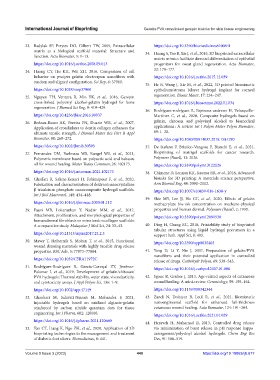Page 448 - IJB-9-3
P. 448
International Journal of Bioprinting Gelatin-PVA crosslinked genipin bioinks for skin tissue engineering
23. Badylak SF, Freytes DO, Gilbert TW, 2009, Extracellular https://doi.org/10.3390/biomedicines8100441
matrix as a biological scaffold material: Structure and 34. Huang S, Yao B, Xie J, et al., 2016, 3D bioprinted extracellular
function. Acta Biomater, 5: 1–13.
matrix mimics facilitate directed differentiation of epithelial
https://doi.org/10.1016/j.actbio.2008.09.013 progenitors for sweat gland regeneration. Acta Biomater,
32: 170–177.
24. Huang CY, Hu KH, Wei ZH, 2016, Comparison of cell
behavior on pva/pva-gelatin electrospun nanofibers with https://doi.org/10.1016/j.actbio.2015.12.039
random and aligned configuration. Sci Rep, 6: 37960.
35. He B, Wang J, Xie M, et al., 2022, 3D printed biomimetic
https://doi.org/10.1038/srep37960 epithelium/stroma bilayer hydrogel implant for corneal
25. Nguyen TH, Ventura R, Min YK, et al., 2016, Genipin regeneration. Bioact Mater, 17: 234–247.
cross-linked polyvinyl alcohol-gelatin hydrogel for bone https://doi.org/10.1016/j.bioactmat.2022.01.034
regeneration. J Biomed Sci Eng, 9: 419–429.
36. Rodríguez-rodríguez R, Espinosa-andrews H, Velasquillo-
https://doi.org/10.4236/jbise.2016.99037 Martínez C, et al., 2020, Composite hydrogels based on
26. Bedran-Russo AK, Pereira PN, Duarte WR, et al., 2007, gelatin, chitosan and polyvinyl alcohol to biomedical
Application of crosslinkers to dentin collagen enhances the applications : A review. Int J Polym Mater Polym Biomater,
ultimate tensile strength. J Biomed Mater Res Part B Appl 69: 1–20.
Biomater, 80: 268–272. https://doi.org/10.1080/00914037.2019.1581780
https://doi.org/10.1002/jbm.b.30593 37. De Stefano P, Briatico-Vangosa F, Bianchi E, et al., 2021,
27. Fernandes DM, Barbosaa WS, Rangel WS, et al., 2021, Bioprinting of matrigel scaffolds for cancer research.
Polymeric membrane based on polyactic acid and babassu Polymers (Basel), 13: 2026.
oil for wound healing. Mater Today Commun, 26: 102173. https://doi.org/10.3390/polym13122026
https://doi.org/10.1016/j.mtcomm.2021.102173 38. Chimene D, Lennox KK, Kaunas RR, et al., 2016, Advanced
28. Ghaffari R, Salimi-Kenari H, Fahimipour F, et al., 2020, bioinks for 3D printing: A materials science perspective.
Fabrication and characterization of dextran/nanocrystalline Ann Biomed Eng, 44: 2090–2102.
β-tricalcium phosphate nanocomposite hydrogel scaffolds. https://doi.org/10.1007/s10439-016-1638-y
Int J Biol Macromol, 148: 434–448.
39. Shie MY, Lee JJ, Ho CC, et al., 2020, Effects of gelatin
https://doi.org/10.1016/j.ijbiomac.2020.01.112 methacrylate bio-ink concentration on mechano-physical
29. Fauzi MB, Lokanathan Y, Nadzir MM, et al., 2017, properties and human dermal. Polymers (Basel), 2: 1930.
Attachment, proliferation, and morphological properties of https://doi.org/10.3390/polym12091930
human dermal fibroblasts on ovine tendon collagen scaffolds:
A comparative study. Malaysian J Med Sci, 24: 33–43. 40. Ding H, Chang RC, 2018, Printability study of bioprinted
tubular structures using liquid hydrogel precursors in a
https://doi.org/10.21315/mjms2017.24.2.5 support bath. Appl Sci, 8: 403.
30. Maver T, Hribernik S, Mohan T, et al., 2015, Functional https://doi.org/10.3390/app8030403
wound dressing materials with highly tunable drug release
properties. RSC Adv, 5: 77873–77884. 41. Yang D, Li Y, Nie J, 2007, Preparation of gelatin/PVA
nanofibers and their potential application in controlled
https://doi.org/10.1039/C5RA11972C
release of drugs. Carbohydr Polym, 69: 538–543.
31. Rodríguez-Rodríguez R, García-Carvajal ZY, Jiménez- https://doi.org/10.1016/j.carbpol.2007.01.008
Palomar I, et al., 2019, Development of gelatin/chitosan/
PVA hydrogels: Thermal stability, water state, viscoelasticity, 42. Sgonc R, Gruber J, 2013, Age-related aspects of cutaneous
and cytotoxicity assays. J Appl Polym Sci, 136: 1–9. wound healing: A mini-review. Gerontology, 59: 159–164.
https://doi.org/10.1002/app.47149 https://doi.org/10.1159/000342344
32. Ghanbari M, Salavati-Niasari M, Mohandes F, 2021, 43. Zandi N, Dolatyar B, Lotfi R, et al., 2021, Biomimetic
Injectable hydrogels based on oxidized alginate-gelatin nanoengineered scaffold for enhanced full-thickness
reinforced by carbon nitride quantum dots for tissue cutaneous wound healing. Acta Biomater, 124: 191–204.
engineering. Int J Pharm, 602: 120660.
https://doi.org/10.1016/j.actbio.2021.01.029
https://doi.org/10.1016/j.ijpharm.2021.120660
44. Hezaveh H, Muhamad II, 2013, Controlled drug release
33. Tan CT, Liang K, Ngo ZH, et al., 2020, Application of 3D via minimization of burst release in pH-response kappa-
bioprinting technologies to the management and treatment carrageenan/polyvinyl alcohol hydrogels. Chem Eng Res
of diabetic foot ulcers. Biomedicines, 8: 441. Des, 91: 508–519.
Volume 9 Issue 3 (2023) 440 https://doi.org/10.18063/ijb.677

